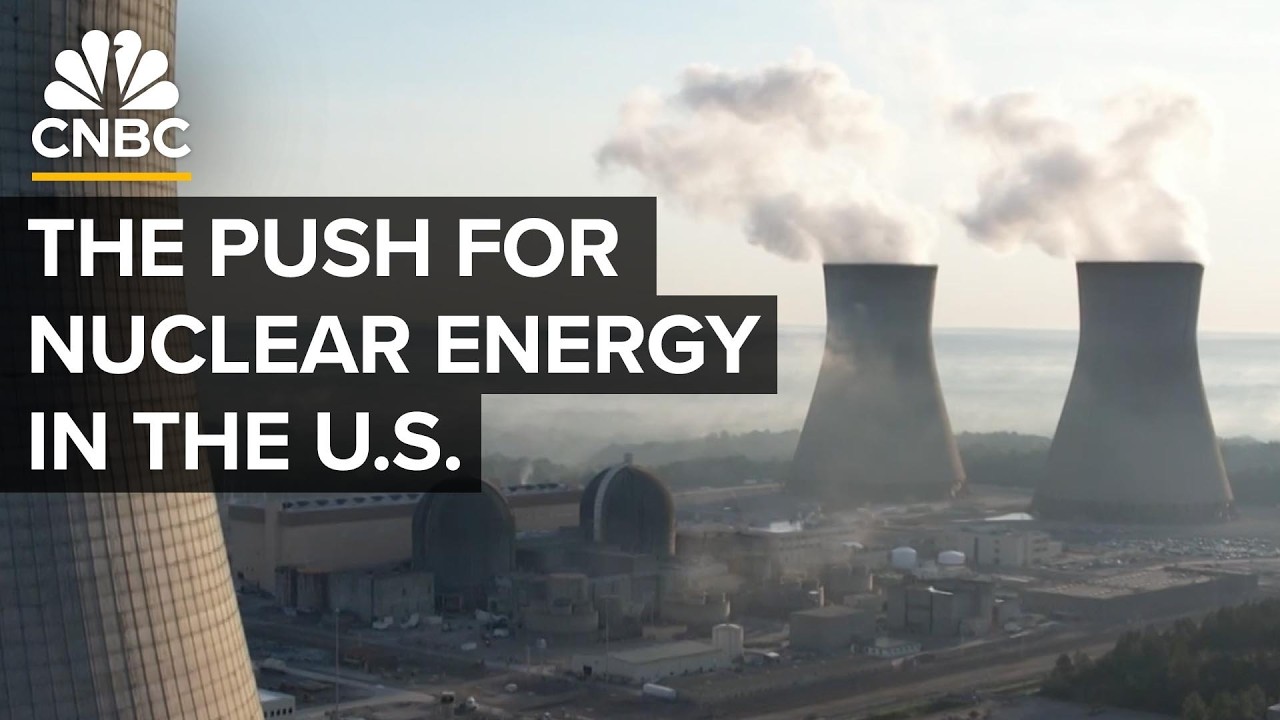This nuclear power plant in Georgia is the nation's
largest and one of the world's most Advanced. Vogtle Unit 3 and 4 came online in 2023 and
2024, Respectively, and are the first new reactors built
from start to finish and connected to the grid In over three decades. Together with a pair of reactors built in the 1980s,
they power more than 2 million homes and Businesses. This is Unit 3 in front of us. That's the shield building. Inside of that is the containment structure, and the
reactor is housed inside of that building. The rise of AI, cloud computing and data centers is
causing demand for electricity to Surge. U.S. Electricity needs are expected to grow 2.4% annually
between 2022 And 2030. But bringing a nuclear power plant to life is
difficult and costly work. One of the challenges with nuclear power is that it's
traditionally been very expensive, and oftentimes Behind schedule. And that happened here at Plant
Vogtle. Vogtle Unit 3 and 4 were initially budgeted at $14
billion, but that price tag more than Doubled. The project also ran seven years behind
schedule. We had some challenges. It was an arduous journey, things that we didn't
anticipate. I mean, from the tsunami in Fukushima to the
contractor going bankrupt to Covid. I mean, there were a number of things that occurred. Plant Vogtle had a lot of promise once upon a time but
it ultimately has Become a serious heartache for people in Georgia
because the ultimate Cost became so incredibly high. And those costs are all passed along to Georgians who
have to pay their electricity bill. With its 54 operating nuclear power plants and 94
reactors, the U.S. Is the world's largest producer of nuclear power,
accounting for 30% of global nuclear Electricity, but at an average age of 42 years those
reactors are getting older, And replacing them is a complex task. So why is it so hard to build nuclear reactors in the
U.S.? And should the new Vogtle reactors be a blueprint or a
cautionary tale for the future? CNBC went to Waynesboro, Georgia to find out. Vogel Unit 4, the newest U.S.
Nuclear reactor to enter service, began operations in
April 2024 with a life Expectancy of up to 80 years its cooling tower stands
60 stories tall, and each reactor Weighs more than the Statue of Liberty. Though it may look like smoke is being emitted, that's
actually water vapor. Nuclear power plants produce no greenhouse gas
emissions during operation, and unlike solar and wind Power produce electricity 24-7. This is a really complex machine here. A lot of highly skilled labor force needs to be here. A lot of specialized parts. You have to bring all of that together in a major way. In the reactor. We're splitting atoms. We're making a tremendous amount of heat. We're using that heat heat to make steam, which is
being used to spin the turbine and the Generator. With the addition of Unit 4 plant Vogtle
has an electricity generating capacity of About 4658MW, surpassing Arizona's Palo Verde Plant and making it the largest generator of clean
energy in the U.S. Unit 3 and 4 are also the first U.S. Deployment of Westinghouse's Ap1000 reactor. Vogel is almost a evolution of the previous reactors
that we've Built in this country. Westinghouse supported the building of 40 plus
reactors and power plants around this Country in the 60s, 70s, 80s and the AP1000 Is learning all the lessons from that past and putting
those into action. The upgrades include a smaller footprint than existing
nuclear reactors with the same generating capacity, A modular construction design that allows for some of
the work to shift to the factory, and fewer Components like valves, cables and pumps. The new reactor is also much safer than ones built in
the past. The AP1000 was designed to withstand aircraft impact,
which is why we have a shield building to protect the Reactors from aircraft impact. There are 750,000 gallons of water in that tank that
sits atop the nuclear reactor. And that is because traditionally, when we've seen
meltdowns like at Fukushima, that happened put simply, Because they lost control to their power source, and
so they weren't able to cool the nuclear Reactor. If in the unlikely event that they lost
power, they could just have all of that water come down And cool the reactor for 72 hours.
But the construction process has faced a number of
headwinds. Vogtle, from the start, was an extraordinarily
ambitious project. When you are pursuing a first of a kind technology in
a environment where you May not have built that technology for a long time,
and you may have started your Project and started your engagement before you've even
fully completed the full design Of that project. Well, there's bound to be some challenges. And this project unfortunately ran into a lot of
challenges. It is hard to pinpoint where things went wrong because
they have been going wrong for so long. Vogtle may be a model for the engineers, but when it
comes to financing, I would say it's a Big warning. This country hadn't built a nuclear plant from start to
finish in over 30 years so putting the band Back together in terms of supply chain, in terms of
the workforce, in terms of the labor resources, there Were a lot of things that had to be brought together
for the first time in a very, very long time. The U.S. generates about 60% of its electricity from
fossil fuels like coal, natural gas and Petroleum, roughly 21% from renewable energy sources,
and about 19% from nuclear Energy. While electricity demand has been flat for the
past two decades, it's starting to Surge. In 2023 alone, about 4.18 trillion kilowatt
hours of electricity Was generated in the U.S. That's 2.2% higher than 2022. Power demand from data centers alone is expected to
grow 160% by 2031. Chat GPT query, for example, needs about ten
times the amount of Electricity to process, as does a Google search. That has sparked renewed interest in nuclear energy
from tech firms and Silicon Valley billionaires like OpenAI chief Sam Altman, who have been investing in
nuclear energy for years. It really feels like we're at a pivotal moment for the
nuclear energy industry, and there is actually a lot Riding on Plant Vogtle. The world's first experimental nuclear power plant, got
its start in Idaho in 1951. The number of U.S. Nuclear reactors peaked at 112, but today there's
concern the U.S. Is falling behind. The United States is certainly falling behind some
countries in the deployment of nuclear Technology, development of nuclear technology, nuclear
R&D. The main leaders right now in this space are notably
China and Russia, countries that the
United States does not typically like to be lagging
behind, especially not both of Them. Across the globe, roughly five dozen nuclear reactors
are under construction, with more than 90 in the Planning stages. China currently has the lion's share with 30 nuclear
reactors under construction, followed by India, Russia and Turkey. But the U.S. Is having a hard time getting large commercial nuclear
reactors off the ground. I wouldn't call it falling behind. We've seen a number of activities where private
companies are now partnering with states and national Laboratories to build this new technology, and it
takes time. And the main point here is we do not want to
compromise the excitement of nuclear At the cost of making a mistake. Critics argue cost overruns have dampened enthusiasm
for new projects. In 2017, the construction of two nuclear reactors in
South Carolina came to a halt due to Rising costs after more than $9 billion was invested. Georgia state regulators in late 2023 approved a plan
that would increase electricity customers bills By roughly $9 per month to pay for the $7.5 billion in
remaining Costs at Plant Vogtle. That's on top of the roughly $5.42 monthly increase
customers saw that Summer. People's concern has shifted this summer into anger. I mean, people are beyond frustrated watching their
bills climb. People are paying $200, $300, $600 utility bills
because we are facing One of the hottest summers we've had in a really long
time. While there is some, you know, of course, appreciation
for any jobs that are brought to Georgia, the question is, who's paying for that? Vogtle Unit 3 and 4 created 800 permanent jobs. At the peak of construction, the site employed more
than 9,000 people. The Department of Energy guaranteed more than $12
billion in loans for the project. Public sentiment to nuclear power in the US has been
shaped by a series of high profile disasters, like Those of Three Mile Island in Pennsylvania. Chernobyl in the former Soviet Union and Fukushima in
Japan. But as new technology makes nuclear reactors safer,
opinions are starting to shift.
A recent study said 56% of U.S. Adults now support more nuclear power plants. We're really looking at a technology that was really
driven on the Back of American innovation and ingenuity in the past,
and the question is, Are we or have we already ceded our leadership. To a new generation of small modular reactors or SMRSs
could help shape that future. Terrapower, founded by Bill gates, broke ground on its
first nuclear project, called Natrium in Wyoming in June 2024. Unlike most U.S. Reactors that use water to absorb heat, Natrium uses
liquid sodium as a cooling agent. The reactor is smaller than traditional ones and is
expected to cost $4 billion. Westinghouse is planning to launch a mini version of
its AP1000 nuclear reactor, called the AP300. The new reactor will generate about a third of
the power of the AP1000, And supply electricity to about 300,000 homes. Small modular reactors appropriate when you need to
supply electricity in remote areas, or When the the bigger grid is not available. In addition, they provide vendors and utilities with
the capability of adding the baseload as you Go, right. So you can construct six modules now and
six modules ten years from now, which means you can Split some of the construction and operational costs
and factor them in the Future. So small modular reactors provide a number of
advantages, but they Cannot be a replacement. They too, have faced headwinds. In 2023 Oregon-based Nuscale power canceled its Idaho
project, a first of a kind Small modular nuclear reactor power plant, after costs
increased more than 50%. But despite those setbacks, many see nuclear energy as
an essential component needed for the world to Transition away from fossil fuels and reach net zero
carbon emissions. If we're truly serious about getting to a carbon free
economy by 2050. You can't do that without nuclear and still invest in
data sciences, artificial intelligence, or Even just increased demands because of continuous
population growth. When you look at the value and you look at the needs of
this electricity grid and what it needs going Forward to meet this demand now and into the future. Nuclear has got to be a part of that future.





